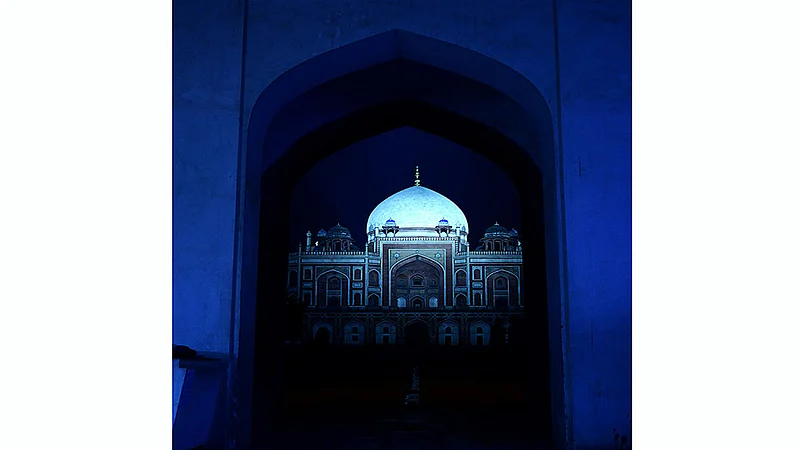If medieval Indian history has one big what-if question, it’s this: what if Dara Shikoh had become emperor instead of Aurangzeb? There’s now a gap between the words ‘Mughal’ and ‘Indian’ in the popular mind—a gap not sustained in history. In the common telling of India’s past, ‘Mughal’ is the name of things built over a land. This idea has been there only since the British: it was born with them. It’s their idea of history that was built over the land. What happened before that was more complex. A meeting of soils, one that produced a natural petrichor, a deeply civilisational aroma that travelled, without leaving a clear sign of its origin. India, as the West got to know it during the colonial age, was transformative for the West. And a key figure mediating that encounter was Dara Shikoh. But where was Dara Shikoh himself? He had vanished into the bone-dry dust of the Doab.
No actor is yet known for portraying him. No Mughal-e-Azam was made for him (though Karan Johar has recently threatened to try). Nor was any political movement waged against him. None was needed, of course. What would you protest against? The translation he steered of the Upanishads? That’s what travelled westward, an army of a subtler kind. The intellectual history of the West would have been different. But Dara Shikoh himself fell off the map in 1659—apparently beheaded on his own brother Aurangzeb’s order.

A portrait of Dara Shikoh
He vanished so completely in fact that, even over 300 years after his death, his exact place of burial remains a mystery. Evidence in history is often coloured in grey, but there’s finally a new beam of light that potentially leads us to his interred body. Historical documents are often mutually contradictory on details. Was he beheaded? Were his head and body buried separately? Which contemporary record should be believed? What was Aurangzeb’s own attitude towards his brother’s grave? For all this, it has been a matter of some consensus that he was buried in Humayun’s Tomb. Only the exact grave was unknown, as the tomb has over 140 graves of different Mughal family members. No historian or researcher had yet managed to fine-tune the lens to afford us more close-range clarity.
Trying to fill that gap, ironically enough, is a government made up of a party not particularly renowned for its love of the Mughals. This February, just before India went into a lockdown and Delhi was dealing with deadly questions of history, the Union ministry of culture decided to try and unlock this big, magic door into the past. It did what governments do, setting up a seven-member committee of India’s top archaeologists to pinpoint Dara’s grave. Before it could do anything, the country-wide lockdown brought everything to a grinding halt. But some three months later, as life tried to resume, and the members were going to assemble, something else happened. Much to their surprise, Sanjeev Kumar Singh, a 49-year-old civil engineer from South Delhi Municipal Corporation, came up with a startling claim. He said he had spotted Dara Shikoh’s grave inside the Humayun’s Tomb.
Yes, you heard that right. Singh says one of the chambers on the first floor of Humayun’s Tomb has Dara Shikoh’s tombstone: it lies there, unmarked, along with two others, which belong to two sons of Akbar, Daniyal and Murad. How did a municipal engineer unlock a door that historians had not managed to even reach? Well, it was a labour of love that took him four years: he studied history, pored over historical documents, did everything a scholar would have done.
A fascinating hunt that has led to a strong claim. Strong enough to earn accolades from at least five members of the committee, which includes Padma awardee K.K. Muhammed, former director general, National Museum, Dr B.R. Mani and three ex-directors of the Archaeological Survey of India: Dr Syed Jamal Hasan, B.M. Pande and Ghulam Syed Khwaja.
So how did Singh find his way around in this unlit part of history? Before setting out on his hunt in 2016, Singh was aware of the popular belief—which even historians had accepted—that Dara’s grave was in Humayun’s Tomb. But beyond that, there was only anonymity. “As a matter of religious principle, graves don’t have any concrete construction on the ground level. That’s why, in Humayun’s Tomb, the actual graves are beneath the plinth, right below the respective tombstones,” Singh says. With material evidence unclear, he needed documentary and literary proof. So he read up on all the details available online on the architecture and design of Mughal gravestones—from Babur’s in Kabul to Bahadur Shah Zafar’s in Rangoon. Then, he pored over the chronicles left by travellers and historians. Next, he went over official Mughal documents and biographies—a goldmine of information, even if not self-sufficient as evidence. “Many prominent Mughal figures have their burial grounds in Pakistan.… Jahangir, Nur Jahan, Asaf Khan,” says Singh. He scanned the dargah complex at Nizamuddin, Qutbuddin Bakhtiar Kaki’s grave in Mehrauli, Akbar’s tomb at Sikandra, the Safdarjung Tomb, Itimad-ud-Daulah’s grave in Agra (one of the prototypes of the Taj), and Taj Mahal itself. And he started seeing patterns: a clear distinction between graves made for males and females, local variations within the same time-frame, and a natural diachronic evolution across the Mughal period.
Contemporary chronicles from the three well-known Western travellers who saw India that time—François Bernier, Jean Baptiste Tavernier and Niccolo Manucci—were a natural source of reference for Singh. But like with everything else, he got only clues. According to Manucci, Dara’s head was buried at the Taj in Agra, and his body at Humayun’s Tomb. Bernier writes of a beheading and a burial at Humayun’s Tomb. Tavernier talks only of the beheading. “Three different versions, but I placed more reliance on Bernier as he was present in Delhi,” says Singh.
The literature also opened up new aspects of Dara’s personality: including the common perception that Dara was a kind of soft counterpart to the harsh Aurangzeb. “When I read Bernier, I came to know that at times he was short-tempered, rude and arrogant with people who used to question him,” says Singh. It’s a disputed point among historians, but it adds depth to what’s otherwise only calendar art. More granularity came to Singh via memoirs such as Amal-i Salih (penned by calligraphist and Shah Jahan’s official biographer Muhammad Saleh Kamboh), Alamgir Namah by Aurangzeb’s handpicked early chronicler Mirza Muhammd Kazim, Maasir i Alamgiri by Saqi Mustad Khan, Muntakhab-al Lubab by Muhammad Hashim Khafi Khan, and Tarikh-i-Farahbakhsh by Muhammad Faiz Bakhsh. Then there were the modern works: Military Memoirs by George Thomas, Wanderings of a Pilgrim by Fanny Parkes, Rambles and Recollections by William Sleeman, Archaeology and Monumental Remains of Delhi by Stephen Carr—right up to the Memoirs of the ASI by Maulvi Muhammad Ashraf Husain.

The tahkhana that holds Dara’s grave
One challenge was language: most original Mughal chronicles are in Persian. “I did face this problem. I know a little bit of Urdu…so I managed to narrow down my search because of the common alphabet, and then took those portions to Dr Aleem Ashraf Khan, head of the Persian department in Delhi University,” Singh says. The most vital clue came from Alamgir Namah, which contained the words, “His body was taken to Humayun’s Tomb and buried in the basement chamber (tahkhana) below the dome, where Daniyal and Murad, Akbar’s son, lay buried....” The clearest reference, yet inconclusive. Singh had to proceed to architecture. “Once I narrowed down my search to ‘below the dome’ of Humayun’s Tomb, I studied the design aspects of each and every tombstone in the chambers under the dome on the first floor,” he says. That helped him zero in on one of the chambers. It had three ‘male’ tombstones. The torchlight was finally closing in. Here were Akbar’s two sons, Murad Mirza and Daniyal Mirza, buried in 1599 and 1605 respectively, and perhaps Dara—whose burial came half a century later, in 1659. The sequence was logical. Murad, who died first, occupied the middle, so Daniyal took one end. Therefore Dara had to be accommodated near the entrance, the other end.
“If you enter the chamber on the first floor, you find Dara’s as the last tombstone. But if you visit the basement, where the actual graves are, the first grave is of Dara because the entrance is on the opposite,” Singh says. How is that conclusion warranted? Because Murad and Daniyal’s graves are almost similar—a time gap of only six years. The third is distinctively different. “As we move closer to the date of Dara’s burial, we find similarities among gravestones constructed around that time,” says Singh. “For instance, the cenotaphs of Akbar’s half-brother, Mirza Aziz Kokaltash, laid out in 1624, Itimad-ud-Daulah’s grave in Agra laid in 1622 and Nur Jahan’s in 1645 in Lahore bear some resemblance with Dara’s, despite local differences.”

An artwork depicts Dara Shikoh’s wedding procession
Singh’s work is now with the experts, and most of them are endorsing it. Says the old ASI hand and Padma awardee, K.K. Muhammed, “Even I wasn’t aware of so many historical and architectural facts. He has churned out the essence from the available resources.” Ghulam Syed Khwaja, who was director, epigraphy, at ASI, too says, “He has done serious and pioneering research.” Dr Mani finds it “convincing and worthwhile”. Pande and Syed Jamal Hasan, both eminent archaeologists, second those views.
But finding Dara has long been a challenge. One that Supriya Gandhi of Yale University, author of The Emperor Who Never Was (2019), the latest historical work on Dara, is well aware of. She hasn’t seen Singh’s research work yet. But she wrote to Outlook on email about previous attempts to identify Dara’s tombstone, including ones that relied on oral traditions. The late Dr Yunus Jaffery, for instance, had his own hypothesis. “There is evidence that his grave had a visible tombstone, news reports from Aurangzeb’s court suggest this,” she says. “But it is hard on the basis of literary evidence to identify its exact location.” The textual evidence is indeed short of conclusive. “The Amal-i Salih gives a metaphorical account of a Quranic verse inscribed on the gate of Time, which other sources have misread and taken literally. The Alamgir Namah merely mentions Dara was buried in the same place as Murad and Daniyal…it does not give the precise location,” she adds.
Thing is, there are five tahkhanas (basements) under the dome in Humayun’s Tomb—their corresponding chambers are on the first floor, which accommodates eleven cenotaphs, six of women and five of men. Humayun’s own is one of the five male cenotaphs, located in the central chamber (No. 1). The south-west chamber (No. 4) has cenotaphs of a man and a woman, chambers 2 and 3 are reserved for women. And three men rest in the north-west one, Chamber 5. Three men, under the dome—both the requirements mandated by Alamgir Namah. The corresponding tahkhana below too is a close fit for the three shahzadas. The cenotaph numbered ‘3’ exhibits all the characteristics of Akbar’s period: the deduction that it belongs to Shahzada Murad, who died on May 22, 1599, is strongly warranted. The first to die, so centrally placed. Cenotaph No. 2, located towards the entrance or the eastern side, features the transitioning architectural characteristics straddling Akbar’s and Jahangir’s periods. Thus, Shahzada Daniyal, who died on March 11, 1605, is a decent guess. The third cenotaph, on the western side, has architectural features proper to Shah Jahan’s period. This is Singh’s Dara.

Gandhi isn’t completely convinced: she feels everyone has been looking for a group of three graves, but such a concatenation isn’t exactly spelt out in contemporary records. “A search for three cenotaphs has guided their exploration. But there is nothing in the Alamgir Namah to suggest the tombstone must be one of three contiguous cenotaphs. Distinguishing features of 17th-century cenotaphs too has subjective elements, and may not lead to a conclusive answer,” she says. There are other possible directions that history gives us, she says. “For instance, the account from Aurangzeb’s court suggests the condition of Dara’s grave was deteriorating, which might mean it was exposed to the elements on the terrace outside instead of being located in the inner building. We cannot be absolutely sure,” she told Outlook. She and other historians, of course, are in no doubt about the sheer seminal influence Dara had.
Prof Akhlaque Ahmad Ansari, a Persian expert at JNU, says Dara was in essence so anti-establishment that he was disowned by his own friends and contemporary scholars. But Dara was not alone in that grand cultural enterprise, where religion wasn’t quite the factor it became with British definitions of India. Knowledge was never circumscribed by identity before the British, says Ansari. “Take Abdul-ul-Qader-Badauni, an orthodox Muslim who translated the Ramayana into Persian. It never courted any controversy. And orthodox Brahmins became great scholars of Islamic religious texts,” he adds. That is the grave that India has lost, and is struggling to recover.


























